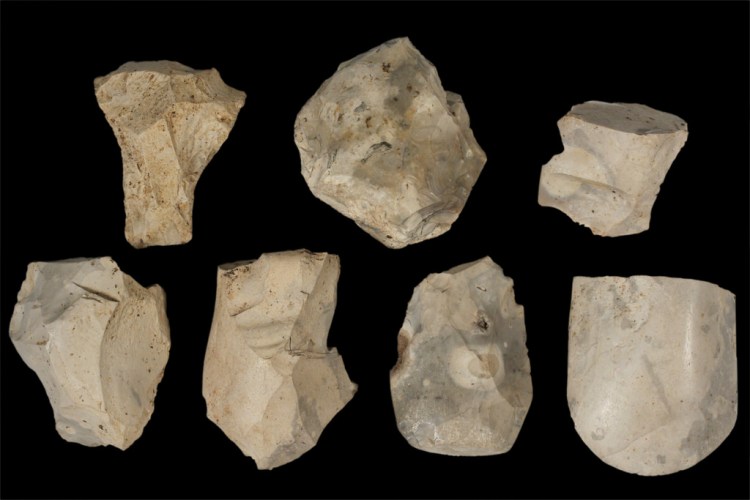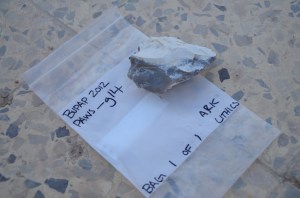This entry details events that took place on May 25, 2017; immediately following the occurrences described here.

When I awoke on the morning of May 25, I was not at my best. My muscles were weak, and I had a bad headache. I was also feeling angry at myself for my carelessness yesterday, which meant I would not be going into the field today. Instead, I would be working in the lab.
I reported to the lab at 7:30 am, and found that I was the first student there. I quickly located Ben: a participant from Santa Monica College who had plentiful experience with archaeological lab work. He directed me to fetch a bucket of water, and while I did so the rest of the crew arrived.
We started out by cleaning lithics, which are artifacts made of stone. We would dunk them in shallow bowls of water, scrub the dirt off of them with toothbrushes, and lay them on screen tables to dry.
Everything had to be done meticulously. The artifacts came in bags that corresponded to specific lots (levels) of specific units (rectangular segments of ground that were being excavated), and we had to make sure that all the lithics from one lot stayed together. To do this, we partitioned off portions of the tables with sticks. Each bag had its own area, which we recorded in our notebooks via sketches. This gave us a record of how the tables were laid out – should we need it.

I found the process of washing lithics to be relaxing and enjoyable. For one thing, we were working with artifacts from the Mayan settlement of Colha. The inhabitants of this site were exceptional craftspeople, and they produced some of the most exquisite lithics in the Mayan world.
We also had pleasant conversations to occupy our time. The lab manager, Sharon (whom we respectfully called Ms. Sharon), was one of the most experienced supervisors at Texas Camp. She thus had a wealth of knowledge about Mayan artifacts, which she was happy to share with us. For instance, Ms. Sharon kept referring to the Maya as “The Great Recyclers.” This is because they often reused or repurposed their tools, rather than discarding them. This doubtlessly saved the Maya time and resources, but it also complicated our task.
The lithics we had washed in the morning were dry shortly after lunch. We then had to sort them.
We counted each piece, with some bags containing over 60. Next, we had to determine which lithics were flakes and which ones were tools. In archaeology, a flake is a segment of stone that broke off during the flint-snapping process; it is essentially refuse. A tool, on the other hand, is a stone instrument that has been purposefully shaped and used.

We were given a few tips to help with the sorting process. If a lithic contained usage wear (disorganized serrations) around the edges then it was likely a tool. Percussion platforms, flat areas where the stone was struck, were also usually found on tools. Oftentimes, an elevated ridge will emanate from this platform and travel down the lithic. This is known as a percussion bulb, and it is caused by kinetic energy moving through the stone.
But the Maya, being The Great Recyclers, frequently used flakes as tools. This made it difficult to classify the lithics we had washed, and I was constantly asking Ben for advice. I am grateful for his patience!

Once we had counted and separated the lithics, we had to re-bag them. We put the flakes and tools from a particular lot into their own plastic baggies, and then deposited both of these into a paper bag. Everything had to be labeled carefully to minimize future confusion. The bags were then recorded in a series of binders, and placed into specially-marked buckets. The work was tedious, but we finished quickly.
This meant I had the rest of the afternoon off. The day’s events were far from over, however, which I will discuss in the following post.
This piece set the stage and one could imagine as the day unfolded. Perhaps some of your writings will manifest in diary or a journal form. If so, I’m sure the audience is engaged in an informative manner.
LikeLiked by 1 person
I appreciate the compliments, Yvonne. However, I’m not entirely sure what you mean by diary or journal form? Are you referring to a specific style of writing?
LikeLiked by 1 person
Yes
LikeLiked by 1 person
Perhaps I will…I don’t have much experience with that style of writing though.
LikeLike
Seems that it was amazing days there dear Josh, made me excited too. Thank you, have a nice day and weekend, Love, nia
LikeLiked by 1 person
It was amazing, Nia; I miss it already! I’m glad that you’re enjoying my posts!
Have a lovely day and weekend too :)
LikeLiked by 1 person
Very interesting! If those stones could speak! :D
LikeLiked by 1 person
In a way they can. Experienced archaeologists can learn a lot about a group of people by examining their stone artifacts.
LikeLiked by 1 person
They Mayans were truly amazing. In addition to repurposing tools, they used water sustainably, building French drains along their roadsides to catch the water when it rained and directing the water to a cistern for use in the dry months. They were really ahead of their time on so many levels. Hope you are recovering. Your trip is amazing!
LikeLiked by 1 person
They absolutely were amazing. One of the other students in the Humboldt group was actually focusing his master’s thesis on Mayan water features in the Rio Bravo area. There were lots of them where we were working, although to the untrained eye they looked like normal depressions in the ground.
LikeLiked by 1 person
Wow, I’d love to see them!
LikeLiked by 1 person
I wish I could show you some pictures, but the landowners of our property stipulated that we couldn’t share photos of active excavations online. Looting is a big problem in Belize, and you never know who’s viewing your photos. I also never thought to photograph some of the unexcavated water features.
However, you can technically visit the Rio Bravo Conservation and Management Area, which is where we were working. There’s a nice ecolodge that’s literally right next to our camp, and I believe there are guides who will take you on tours of some of the archaeological sites. Here’s the link, in case you’re interested:
http://www.pfbelize.org/tourism/?page_id=16
LikeLiked by 1 person
Wow, thanks! I’ll put it on the list!
LikeLiked by 1 person
You should! The grounds of the lodge are beautiful, and the guides are very knowledgeable and friendly. I spoke to them a few times, and would occasionally walk over to the ecolodge.
LikeLiked by 1 person
A bit of a return to civilization, eh?!👍
LikeLiked by 1 person
A little bit! It was nice to be in a place that was less crowded than camp.
LikeLiked by 1 person
I was getting Indiana Jones vibes while reading this ! Lol and I totally imagined your in a khaki hat and shorts working on them stones 😂
LikeLiked by 1 person
Haha! I was wearing shorts, but I usually chose to wear a bandana instead of a khaki hat. Much more comfortable! The hat I brought turned out to be horrible.
LikeLike
To hold thoss artifacts. Magical! I’m so glad you got to do it. An experience of the lifetime ☺☺
LikeLiked by 1 person
It was incredible: especially now that I’ve had time to reflect on my experiences. At the time I was just focused on doing a good job, but now I realize what an incredible experience it was. Holding those artifacts connected me in some way to people who lived hundreds of years ago, and who were born into a very different culture than my own. What a privilege!
LikeLike
As magical as it can get!
LikeLiked by 1 person
For sure!
LikeLike
I can’t find my like botton lol😶
LikeLike